
1. Linking Concept 1:What's for Lunch?
1.1. Students investigate food and fibre production and food technologies used in modern and traditional societies. They design and make a lunch item that includes modern and traditional technologies and explore how people in different times developed food and fibre technologies to meet human needs.
1.2. Humanities and Social Sciences
1.2.1. Sequence information about people’s lives, events, developments and phenomena using a variety of methods including timelines (ACHASSI125)
1.3. Literacy
1.3.1. Participate in and contribute to discussions, clarifying and interrogating ideas, developing and supporting arguments, sharing and evaluating information, experiences and opinions (ACELY1709)
1.4. Science
1.4.1. Identify, plan and apply the elements of scientific investigations to answer questions and solve problems using equipment and materials safely and identifying potential risks (ACSIS103)
1.4.2. Scientific knowledge is used to solve problems and inform personal and community decisions (ACSHE100)
2. Linking Concept 2: Biome Terrariums.
2.1. Students will participate in discussions on sustainability, specifically the United Nations Sustainable goal 15 ‘Life on Land. They will then research what environments are required to produce specific food and fibres. Using this knowledge, students will design biome terrariums that cater for these requirements. It will be presented as an open-ended, collaborative, and creative problem-solving learning experience
2.2. Science
2.2.1. The growth and survival of living things are affected by physical conditions of their environment (ACSSU094)
2.3. Literacy
2.3.1. Participate in and contribute to discussions, clarifying and interrogating ideas, developing and supporting arguments, sharing and evaluating information, experiences and opinions (ACELY1709)
3. Linking Concept 3: Farm to table.
3.1. Students will uncover how a dairy farm works and why eating foods with plenty of nutrients is crucial.Students will identify what sustainable management practices are used within the industry and throughout production.
3.2. Humanities & Social Sciences
3.2.1. How the concept of opportunity cost involves choices about the alternative use of resources and the need to consider trade-offs (ACHASSK149)
3.2.2. The effect that consumer and financial decisions can have on the individual, the broader community and the environment (ACHASSK150)
3.2.3. The reasons businesses exist and the different ways they provide goods and services (ACHASSK151)
3.3. Technologies
3.3.1. Investigate characteristics and properties of a range of materials, systems, components, tools and equipment and evaluate the impact of their use (ACTDEK023)
3.4. Science
3.4.1. The growth and survival of living things are affected by physical conditions of their environment (ACSSU094)
4. Curriculum Links
4.1. Sustainability in Technologies
4.2. Environment
4.3. Economics
4.4. Social
4.5. General Capabilities:
4.6. ICT General Capabilities
4.7. Critical and creative thinking
4.8. Personal and social capability
4.9. Ethical understanding
4.10. Process & Production Skills:
4.11. Define a problem, and a set of sequenced steps, with users making decisions to create a solution for a given task (WATPPS33)
4.12. Identify available resources (WATPPS34)
4.13. Design, modify, follow and represent both diagrammatically, and in written text, alternative solutions using a range of techniques, appropriate technical terms and technology (WATPPS35)
4.14. Select, and apply, safe procedures when using a variety of components and equipment to make solutions (WATPPS36)
4.15. Develop collaborative criteria to evaluate and justify design processes and solutions (WATPPS37)
4.16. Work independently, or collaboratively when required, considering resources and safety, to plan, develop and communicate ideas and information for solutions (WATPPS38)
4.17. Knowledge & Understanding
4.17.1. Sequencing the process of converting ‘on-farm’ food or fibre products into a product suitable for retail sale, that is, the ‘paddock to plate’ supply chain, or when making yarn or fabric from fibre
4.17.2. Identifying work practices that show an understanding of nutrition, environmental considerations, hygiene and food safety when designing and making a food product, for example washing fruit and vegetables carefully to remove residues, safe disposal of cooking oils to avoid environmental damage, refrigerated storage of highly perishable foods
4.17.3. Investigating and experimenting with different tools, equipment and methods of preparing soil and the effect on soil quality and sustainability including conserving and recycling nutrients, for example when designing a sustainable school vegetable garden or cropping area

